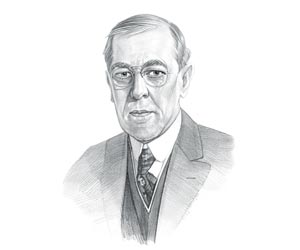|
|
|
|
|
The interception and de-coding of the Zimmermann Telegram revealed a promise to the Mexican Government that Germany would help Mexico recover the territory it had ceded to the USA (Texas, New Mexico, and Arizona) following the Mexican-American War. The Zimmerman telegram sparked nationwide outrage during WW1 and helped to bring about American participation in the Great War.
What was
the Zimmermann Telegram?
When was
the Zimmermann Telegram sent?
The
Zimmermann Telegram Code / Cipher Facts about
Zimmermann Telegram The Zimmermann Telegram was a top secret coded message sent on January 16, 1917 from the German Foreign Minister Arthur Zimmermann to Germany's ambassador in Mexico at the height of WW1. The purpose of the Zimmerman telegram was to give Heinrich von Eckhardt, the German ambassador in Mexico, a set of coded instructions should the neutral United States enter WW1 on the side of the Allies. Direct telegraph transmission to Mexico was not possible because the British had cut Germany's transatlantic telegraph cable. However, the United States allowed a limited use of its diplomatic cables for Germany to communicate with its ambassador in Washington. The encrypted telegram was therefore first received by Johann von Bernstorff, the German ambassador in Washington D.C., who then forwarded the message onto the German Ambassador in Mexico, Heinrich von Eckardt. On January 17, 1917 Room 40, the British Admiralty code breaking operation, intercepted the coded Zimmerman telegram and immediately started work on deciphering the encrypted message... Johann von Bernstorff, the German ambassador in Washington D.C., forwarded the message on to Heinrich von Eckardt, the German Ambassador in Mexico, Heinrich von Eckardt on January 19, 1917. Ambassador Heinrich von Eckhardt passed the content of the Zimmerman telegram to Venustiano Carranza, the President of Mexico. American had maintained a neutral position during WW1 however Germany was about to go back on the 'Sussex Pledge' to America (not to sink merchant ships without due warning) The top secret content of the Zimmerman telegram was a diplomatic bombshell and therefore sent in code. The summary of the missive was:
Why did Germany risk bringing the US into WW1 on the side of the Allies? Answer: The situation with Mexico:
On February 1, 1917 Germany begin unrestricted U-boat warfare in the Atlantic. US ships came under attack from German U-Boats (submarines) and the USA broke off diplomatic relations with Germany Meanwhile the British code breakers working in British cryptographic office known as "Room 40" were cracking the encrypted message. The code breaking organization came to be known as "Room 40" because of its location in the Old Admiralty Buildings. Room 40 Code breakers Nigel de Grey and William Montgomery recognized that the message was encoded in a German diplomatic code system that they called '0075'. They had been working on the 0075 code for months and it was already partially broken when they started work on the Zimmerman telegram. The code breakers of Room 40, the British Admiralty intelligence department of cryptanalysis, completed the task on February 5, 1917, handed the message to the British Government. It was clear to the British Government that the message was invaluable in finally drawing the United States into WW1 on the Allied side, a long-time British objective. But there were serious problems with sharing the information as the very existence of Room 40 was one of Britain's greatest secrets against the Germans during WW1 and that London was monitoring neutral diplomatic traffic. The Zimmermann Telegram was handed over to the American ambassador to Britain on 23 February, 1917. The US ambassador Walter Page then passed the outrageous content of the telegram to President Woodrow Wilson on 24 February, 1917. A scheme was devised (involving an agent in Mexico and a burglary) to conceal how the message had become available and also how the U.S. had gained possession of a copy. On 26 February, 1917 President Woodrow Wilson proposed to Congress that the U.S. should start arming its ships against possible German attacks. President Woodrow Wilson then authorized the State Department to make public the Zimmermann Telegram. On March 1, 1917 the Zimmermann telegram was published in the press and inflamed American public opinion against Germany and helped convince Congress to declare war against Germany. Some in the United States, who still held out for neutrality, at first claimed the telegram was a fake but his notion was dispelled two days later, when Arthur Zimmermann confirmed its authenticity. On April 6, 1917 President Wilson declared war on Germany and fought with the allies in WW1 until the war ended on 11 November 1918. Mexican President Venustiano Carranza formally declined the proposal on April 14, 1917 when the US had already declared war against Germany.
What did the Zimmerman Telegram say? Full Text of the Zimmermann
Telegram (translation of the German)
We intend to begin on the first of February
unrestricted submarine warfare. We shall endeavor in spite of this
to keep the United States of America neutral. Signed: ZIMMERMANN |
| US American History |
| 1913-1928: WW1 & Prohibition |
|
|
|
|
|
First Published2016-04-19 | |||
|
Updated 2018-01-01 |
Publisher
Siteseen Limited
| ||
|
|

